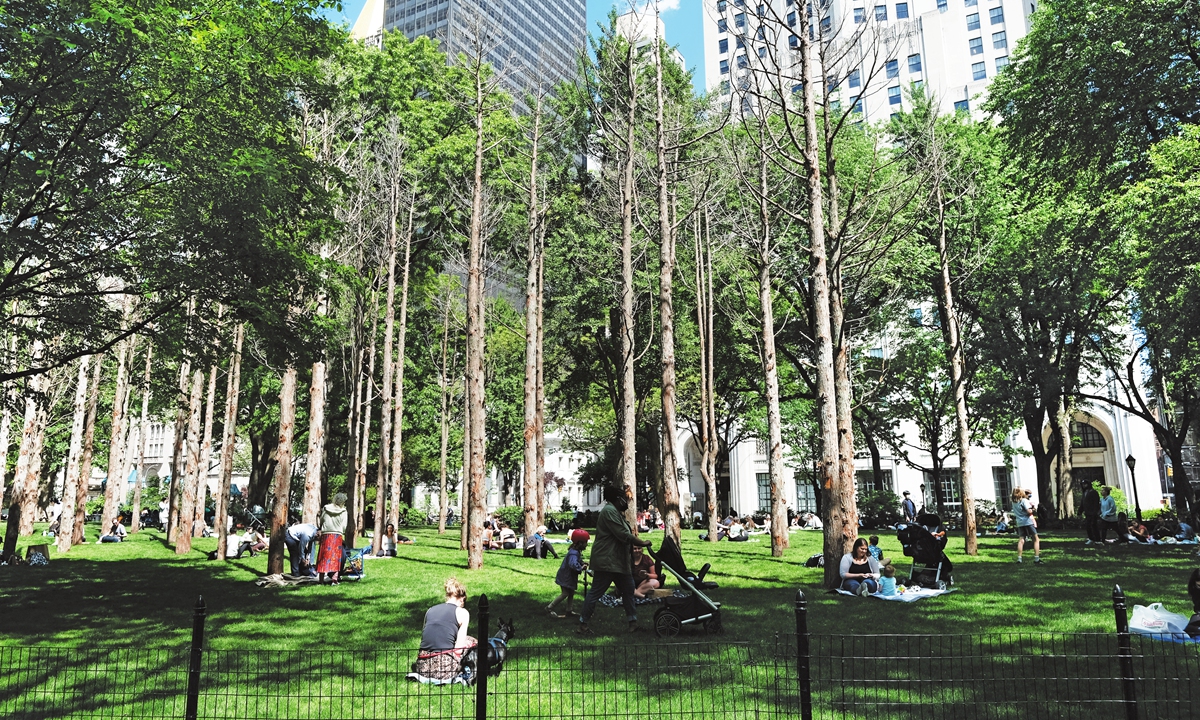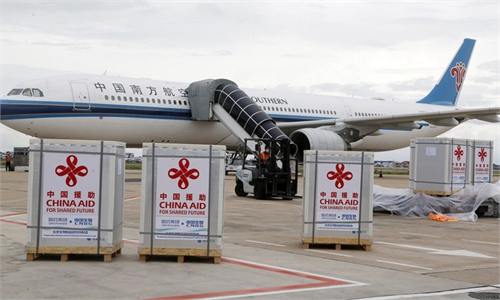
People enjoy a warm afternoon beside the artistic installation "Ghost Forest" in New York City on May 13. Photo: AFP
From lettuces farmed on New York's skyline to thick corridors of trees occupying once-desolate Colombian roadsides, green initiatives are running wild in cities around the world.
At a time when coronavirus disease lockdowns have amplified the need for nature in urban areas, AFP has gathered images and footage of projects optimizing precious city space.
Replanting initiatives have sprouted up since the start of the 21st century as urban development goals have shifted and alarm about global warming has grown. And they've had an impact.
In nine cities in the world, thanks to planting schemes on walls and roofs, the temperature during the warmest month in so-called street canyons - flanked by high-rise buildings on either side - can be reduced by 3.6 to 11.3 degrees Celsius at the hottest time of day, according to a report by the French Agency for Ecological Transition.
Green spaces have also been shown to improve health and well-being, including by reducing stress, anxiety and depression, improving attention and focus, better physical health and managing post-traumatic stress disorder, said Stephanie Merchant of Bath University's department for health.
"However, it's about where they are created in relation to the needs of the local communities," she added.
So, are all urban replanting projects worthwhile?
For a scheme to be seen as "virtuous," it must fulfill as many functions as possible, economist and urban planner Jean Haentjens, who co-authored the book Eco-urbanisme (Eco-Urbanism), told AFP.
In addition to lowering the temperature, he said it should also preserve biodiversity, improve well-being, raise awareness, be appealing to residents and suitable for its social context.
Singapore's otherworldly garden
The imposing "forest" of giant manmade trees constructed from reinforced concrete and steel, luxuriantly covered in real flora and fauna, is a Singapore landmark.
Towering 25 to 50 meters over the city-state's new business district, the 18 solar-powered supertrees light up the night sky, their canopies looking like flying saucers.
Vast glass greenhouses also showcase exotic plants from five continents, as well as plant life from tropical highlands up to 2,000 meters above sea level, complete with an artificial mountain and indoor waterfall.
The Gardens by the Bay project, awarded the World Building of the Year in 2012, says the idea was to create "a city in a garden."
But pointing to the construction and maintenance costs, Philippe Simay, a philosopher on cities and architecture, called it a "disneyisation" of nature. "Why make trees from concrete when you can have real ones," he asked.
It's a great public relations effort, says Claire Doussard, a teacher in planning and development and a research fellow at the French National Centre for Scientific Research, highlighting its "technical know-how" and awareness-raising among the public about the threat of climate change.
Farming on a New York rooftop
With buildings all around, the Statue of Liberty in the distance and heavy traffic below, the Brooklyn Grange rooftop farm grows more than 45 tons of organic produce a year.
It was launched about a decade ago by friends living in New York who wanted "a small sustainable farm that operated as a business," co-founder Gwen Schantz said.
In a built-up city, Simay noted, it had been found that such initiatives were "fighting effectively against heat islands" where heat-conducting concrete and asphalt make cities warmer than their surroundings.
Now covering three rooftops, totalling more than 22,000 square meters, the farm cultivates a wide variety of vegetables.
But it has to limit the soil depth to about 30 centimeters and "irrigate the soil a little more frequently, because it dries out very quickly," Schantz said.
Doussard said that the logistics of rooftop farming, where water and soil must be hauled up and produce brought down, means: "These farms must be profitable because there are a lot of constraints."
Living in Milan's vertical forest
By adorning two high-rise apartment buildings from top to bottom in more than 20,000 trees and plants, Italian architect Stefano Boeri said he'd wanted to make trees "an essential component of architecture" and create something that could "contribute to reducing pollution."
The Bosco Verticale (Vertical Forest) in the heart of Milan sees cherry, apple and olive trees spilling over balconies alongside beeches and larches, selected and positioned according to their resistance to wind and preference for sunlight or humidity.
The award-winning project opened in 2014 and, said Simay, is "an indisputable technical feat with an ecosystem function, a large diversity of trees, plants, insects."
But, he added, concrete and steel were required to support it all, while setting it up was costly and energy-consuming.
And the price that the luxury apartments go for is also often a talking point.
Medellin's 'green corridors'
Colombia's second-biggest city has won plaudits and awards for its "green corridors," an interconnected network that has transformed urban thoroughfares once lacking in nature and strewn with rubbish where drug addicts gathered.
Now the 30 tree- and flower-filled corridors connect up with Medellin's existing green spaces such as parks and gardens.
"There's been a real reflection citywide on the species chosen, the habitability, the constraints," Doussard said.
The overall effect has reduced the temperature by two degrees Celsius and helped purify the air, according to a city authority video.
Bees and birds have returned, residents are engaged and gardening jobs have been created, it added.



